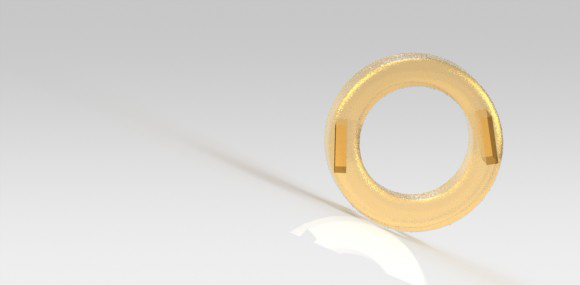Put a Medical Advisor on Your Finger
NEWS
It’s hard not to invoke the epic fantasy catchphrase from The Lord of the Rings: “one ring to rule them all.” The KTH spin-off company SenseM wants to put a band on your finger that will do everything from monitoring your health to controlling your Xbox.

The unusually proficient new ring has been developed and patented by KTH researcher Stanley Wissmar and several colleagues, who see a range of potential uses beyond patient oversight and gaming applications. These might include keeping track of an exercise regimen or as a replacement for credit cards.
As a first step, Wissmar and his partner in SenseM, Bosse Hammarlund, have identified three distinct business areas for the wearable technology: medical monitoring, access and authentication, and as an electronic control unit.
“We already have a prototype for monitoring patients with Parkinson’s disease,” Wissmar says. “And we expect to have a demonstration unit for authentication applications within a month.”
The idea was hatched four years ago, when Wissmar was on a run through the woods, listening to music on his mobile phone’s MP3 player and having to fumble in his pocket every time he wanted to change tracks.
“I was thinking how great it would be to have a simple way to bring up a new tune or adjust the volume without digging out the phone,” he says. “Seeing the problem from the user perspective, it just hit me: ‘A ring, of course!’”

Wissmar began his career researching materials and components in 2001, gaining insight over the years into how sensors work and how they can be integrated into various materials. He has wrestled with packaging, design and miniaturisation of logic circuits. Also part of the equation are bttery power, privacy and security.
Wissmar says the SenseM technology fills a large, unmet need faced by Parkinson’s patients. Stationary tools currently used by hospitals for symptom assessment provide only limited information while requiring the patient to come to the hospital. In combination with other tools developed together with Karolinska University Hospital, the SenseM ring provides objective, real-time information that doctors can use to assess patient condition.
“In practical terms, the ring transfers data to a smartphone, which in turn sends the encrypted information to the patient’s physician,” Wissmar explains.
He adds that the ring could be useful for other conditions that cause tremors, including epilepsy, attention deficit disorder, and alcohol-related diseases.
Wissmar also describes how the new technology can improve security in handling sensitive patient information. “We take personal integrity very seriously, and we’ve put a lot of effort into security,” he says.
The cost of the ring will depend largely on which functions are included, but Wissmar says the price will be relatively modest once large-scale production commences.
“It should be possible to market a plastic ring for around $500, while a similarly equipped gold ring could rise to $2000. These figures are within reason for most consumers,” he says.
He adds that the original idea remains important: the ring should be a well-designed, attractive accessory that masks the integrated electronics.
“Regardless of its functionality, the ring has to maintain its aesthetic appeal,” Wissmar says.
But how will it stand up to being used in the real world, where rough conditions are sometimes unavoidable?
“When we make the case of metal, the electronics are hermetically enclosed, so moisture isn’t a problem,” he says. “It’s also shock-resistant to a certain extent, but we’re still testing to see exactly how much it can take.”
What will it take to make the ring a commercial success?
“Our engineers have have done a good job developing the technologies and building the IT infrastructure, but the interface between technology and users is still clumsy,” Wissmar says. “For example, you usually have to hold the cell phone at the same time you’re using the ring. My mantra throughout the development phase has been to apply existing technology in ways that don’t limit the user’s freedom of movement. You have to focus on the user’s perspective.”
How many functions can be built in? Can you construct a super-ring?
“The battery can be a limitation in designing a multi-function ring. We have ideas for how to solve that problem, but it may take a while,” says Wissmar.
For more information: Stanley Wissmar, +46-70-772 78 30; wissmar@kth.se.
By Peter Larsson. Edited by Kevin Billinghurst

